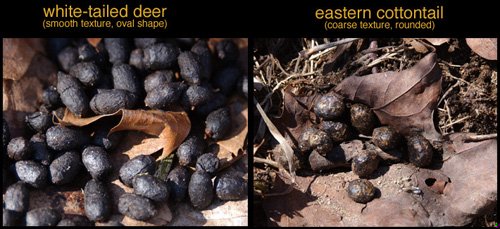Deer poop vs rabbit poop – a fascinating comparison that often leaves many wondering about the distinct differences between these two types of animal waste. If you’ve ever stumbled upon these droppings in your garden or while out exploring nature, you might have found yourself pondering which creature left its mark. Fear not, for we are here to shed some light on this scatological mystery! In this article, we will delve into the characteristics, size, shape, and even the potential uses of deer and rabbit poop, unraveling the secrets hidden within these little organic packages. So, let’s embark on a journey of discovery, exploring the intriguing world of deer poop vs rabbit poop!
Deer Poop vs Rabbit Poop: A Detailed Comparison
Introduction
As nature enthusiasts, we often encounter various forms of wildlife scat during our outdoor adventures. While some may find it distasteful, poop, also known as feces or droppings, can actually provide valuable insights into an animal’s diet, health, and behavior. In this article, we will delve into the fascinating world of deer poop and rabbit poop, comparing their characteristics, uses, and impacts on the environment. So, let’s dive in and explore the world of animal droppings!
Physical Characteristics
When it comes to comparing deer poop and rabbit poop, there are some noticeable differences in their physical appearance:
Deer Poop
Deer droppings are typically larger in size compared to rabbit droppings. They are often cylindrical or pellet-shaped, resembling dark grapes. The color of deer poop can vary depending on the animal’s diet, ranging from dark brown to black. Typically, fresh droppings have a moist and shiny appearance, but they gradually dry out and become lighter over time.
Rabbit Poop
Rabbit droppings, also known as rabbit pellets, are much smaller and rounder than deer droppings. They are usually pea-sized and resemble small beads. Rabbit poop is typically brown in color, and their shape is consistent due to the unique digestion process of rabbits. Unlike deer poop, rabbit droppings are usually dry and powdery.
Key Difference:
– Deer poop is larger and cylindrical, resembling dark grapes.
– Rabbit poop is smaller, rounder, and pea-sized.
Composition and Odor
Understanding the composition of animal droppings can provide valuable information about their diet and overall health. Let’s take a closer look at the composition and odor of deer and rabbit poop:
Deer Poop
Deer poop is primarily composed of plant matter, such as leaves, twigs, and grass, due to the herbivorous nature of deer. It may also contain small remnants of fruits or nuts if they are part of their diet. Since deer have a complex digestive system, their droppings often have a fibrous texture and may contain visible bits of undigested plant material. In terms of odor, fresh deer droppings can have a strong musky smell, particularly in the breeding season when males mark their territory.
Rabbit Poop
Rabbit droppings primarily consist of digested plant material, such as grass, hay, and leafy greens. Due to rabbits being strict herbivores, their droppings do not contain any residue of animal protein. Rabbit poop has a distinct odor that is often described as earthy or hay-like. The odor is generally mild and not overpowering.
Key Difference:
– Deer poop contains visible bits of undigested plant material.
– Rabbit poop has a mild and earthy odor.
Environmental Impact
Both deer and rabbit poop play a crucial role in the ecosystem. The feces of these animals contribute to the nutrient cycling and health of the environment in their own unique ways:
Deer Poop
Deer poop is rich in organic matter, which serves as a valuable source of nutrients for plants and other organisms. As deer graze on vegetation, their droppings help fertilize the soil by adding essential nutrients like nitrogen, phosphorus, and potassium. This fertilization process aids in the growth and regeneration of plant species, contributing to the overall biodiversity of an ecosystem. Additionally, the presence of deer droppings can attract other herbivores that feed on them, creating a food chain that supports a variety of wildlife.
Rabbit Poop
Rabbit droppings are also beneficial to the environment. Their pellet-like structure allows for efficient nutrient dispersion as they decompose on the ground. This process enriches the soil and promotes the growth of vegetation, making the area more habitable for other species. In some cases, rabbit poop can even help to prevent soil erosion by acting as a natural mulch. However, excessive rabbit populations in certain areas can result in overgrazing and potential damage to the local plant life.
Key Difference:
– Deer poop contributes to the growth and regeneration of plant species, supporting biodiversity.
– Rabbit poop enriches the soil and helps prevent soil erosion but can be harmful if overgrazing occurs.
Uses in Wildlife Tracking and Observation
Animal droppings, including deer and rabbit poop, can provide valuable insights for wildlife tracking and observation enthusiasts. Here’s how they can be used in the field:
Deer Poop
Tracking deer through their droppings is a common practice among nature enthusiasts, hunters, and wildlife researchers. By examining the characteristics of deer poop, it is possible to determine the presence, size, and behavior of deer in a particular area. Fresh droppings can indicate recent deer activity, while the presence of specific plant material in the droppings can provide clues about their diet and preferred habitats. Additionally, the size and shape of deer droppings can help differentiate between different deer species, such as white-tailed deer and mule deer.
Rabbit Poop
Rabbit poop can also be useful for tracking and observing these small mammals in their natural habitats. The presence of rabbit droppings can indicate the presence of rabbits in a particular area, allowing researchers or enthusiasts to study their behavior, preferred food sources, and potential impacts on the ecosystem. Due to the powdery texture of rabbit droppings, they can easily disintegrate and blend with the surrounding environment, making them more challenging to track compared to larger animal droppings.
Key Difference:
– Deer droppings can help track deer species and provide insights into their diet and behavior.
– Rabbit droppings indicate the presence of rabbits and their impact on the ecosystem.
In conclusion, while deer poop and rabbit poop may seem similar at first glance, a closer examination reveals distinctive characteristics and impacts associated with each. Deer droppings are larger, contain visible traces of undigested plant material, and contribute significantly to the fertilization and growth of plant species. On the other hand, rabbit droppings are smaller, drier, and have a milder odor, enriching the soil and promoting the growth of vegetation. Both types of droppings play a crucial role in maintaining the balance and health of their respective ecosystems.
So, the next time you come across animal droppings during your outdoor adventures, take a moment to appreciate the valuable insights they provide into the natural world around us. Whether it’s deer poop or rabbit poop, each one tells a unique story about the animals that inhabit our environment. Happy tracking!
How to Identify Rabbit or Bunny Poop / Droppings!
Frequently Asked Questions
What is the difference between deer poop and rabbit poop?
Deer poop and rabbit poop may appear quite similar at first glance, but there are some key differences between the two. While both are animal droppings, understanding these distinctions can be helpful, particularly for those interested in wildlife identification or animal behavior.
How can you differentiate deer poop from rabbit poop?
The size and shape of the droppings can help distinguish between deer poop and rabbit poop. Deer droppings are usually larger, typically resembling small oval pellets, similar to chocolate-covered raisins. In contrast, rabbit droppings are much smaller and rounder, resembling tiny balls or marbles.
What about the color and texture of deer and rabbit droppings?
Deer droppings commonly have a dark brown or black color, although this can vary depending on their diet. They also tend to be more firm and solid in texture. On the other hand, rabbit droppings are usually lighter in color, ranging from brown to tan, and have a softer, almost granular texture.
Do deer and rabbits have different droppings habits?
Yes, deer and rabbits exhibit different droppings habits. Deer tend to deposit their droppings in small piles or scattered groups throughout their territory, commonly referred to as “scat.” In contrast, rabbits often leave their droppings in a scattered manner along their pathways or near their burrows.
Can you determine an animal’s diet from their droppings?
To some extent, it is possible to identify an animal’s diet by examining their droppings. Deer, being herbivores, primarily consume plant matter such as leaves, twigs, and grass. Consequently, their droppings may contain remnants of these food sources. Rabbits, too, feed on vegetation, and their droppings may contain partially digested plant material.
Final Thoughts
Deer poop and rabbit poop may seem similar at first glance, but there are key differences between them. Deer droppings are typically larger in size and have a cylindrical shape, whereas rabbit droppings are smaller and rounder. Additionally, deer poop tends to be darker in color and may contain remnants of plants, while rabbit poop is lighter in color and usually consists of grass. Understanding these distinctions can be useful for identifying the animals in an area based on their droppings. So, next time you come across deer poop vs rabbit poop, you’ll be able to distinguish them with ease.




